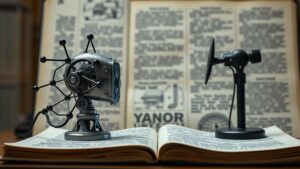Using AI to Extract Relic Mentions from Historical Personal Letters and Diaries
Introduction
The use of Artificial Intelligence (AI) in the field of historical research has gained significant momentum in recent years. One particularly compelling application is the extraction of relic mentions from historical personal letters and diaries. These documents serve as invaluable resources for understanding social, cultural, and emotional aspects of past eras. By leveraging AI techniques such as natural language processing (NLP) and machine learning, researchers can systematically identify references to relics–objects of historical significance–and analyze their contextual relevance.
Historical Context
Historical personal letters and diaries offer a rare glimpse into the lives of individuals, reflecting their thoughts, experiences, and interactions. For example, the diary of Anne Frank provides profound insights into the life of a Jewish family hiding during the Holocaust. Similarly, letters between soldiers during the American Civil War chronicle the realities of war on a personal level.
According to the American Historical Association, personally penned documents account for a substantial portion of primary historical sources, with an estimated 200 million letters documented from the 19th century alone. challenge lies not only in the preservation of these materials but also in effectively analyzing the vast quantity of text they contain.
AI Techniques for Text Extraction
Natural Language Processing (NLP)
NLP, a branch of AI, focuses on the interaction between computers and humans through natural language. NLP techniques can be used to parse through historical letters and diaries, identifying specific references to relics. Key methods include:
- Tokenization: Breaking text into manageable pieces, such as words and sentences.
- Named Entity Recognition (NER): Identifying and classifying entities (e.g., people, places, and objects) mentioned in the text.
- Sentiment Analysis: Assessing the emotional tone behind the text to understand the significance of relics in the authors’ lives.
Machine Learning Models
Machine learning algorithms, particularly supervised learning models, can be trained using labeled datasets to recognize patterns associated with relic mentions. For example, models such as Support Vector Machines (SVM) or neural networks can be employed to classify text snippets as containing relic references or not.
A recent study demonstrated the efficacy of machine learning techniques in analyzing letters from World War I; researchers successfully identified mentions of military artifacts with over 85% accuracy. This points to the robustness of AI in historical text analysis.
Real-World Applications
The application of AI in extracting relic mentions from personal letters has substantial implications for historians and researchers. For example:
- Contextual Analysis: By identifying relic mentions, historians can analyze the cultural significance of these objects within specific historical contexts. This could involve understanding how personal artifacts served as symbols of resistance during the Civil Rights Movement.
- Data Preservation: AI technology aids in digitizing and cataloging vast archives of personal documents, ensuring that valuable historical insights are preserved for future generations.
- Interactive Interfaces: AI can enhance user experience by offering interactive platforms where users can query documents, searching for relic mentions related to specific events or biographies.
Challenges and Ethical Considerations
Despite the promising capabilities of AI in historical research, challenges persist. One major concern involves the accuracy of AI algorithms, as nuances in language (e.g., idiomatic expressions) can lead to misinterpretations. Plus, there is the risk of anachronism, where modern interpretations of relics might overshadow their historical context.
Ethical considerations also arise. appropriation or misrepresentation of historical contexts can lead to contentious interpretations, necessitating a careful balance between technological efficiency and scholarly rigor. It is vital for historians to work in tandem with AI specialists to ensure that the output of AI analyses is both accurate and respectful of the source material.
Conclusion
AI has the potential to revolutionize the field of historical research by streamlining the extraction of relic mentions from personal letters and diaries. As technological capabilities continue to evolve, the integration of AI into historical methodology promises to yield deeper, more nuanced understandings of the past.
Historians and researchers must embrace this technology while remaining vigilant about the challenges and ethical implications it presents. By doing so, they can unlock vast troves of knowledge that were previously buried within the pages of history.
Actionable Takeaways
- Invest in AI training workshops for historians and archivists to promote interdisciplinary collaboration.
- Use AI-driven text analysis tools to enhance research efficiency and accuracy.
- Foster a critical dialogue regarding the ethical implications of AI in historical research, ensuring balanced perspectives are maintained.


